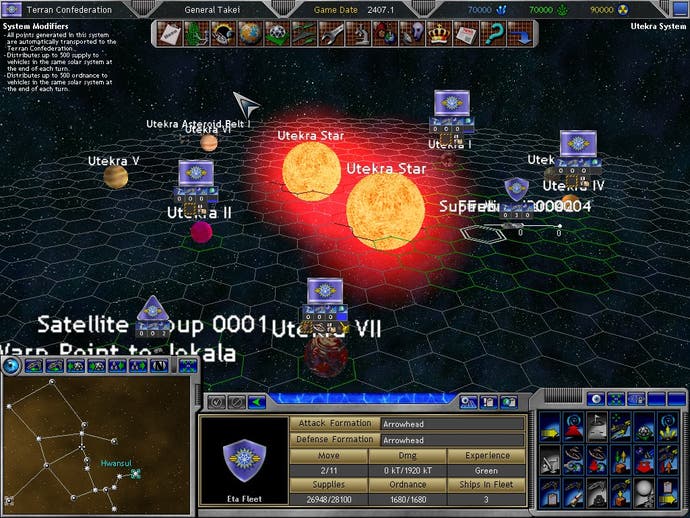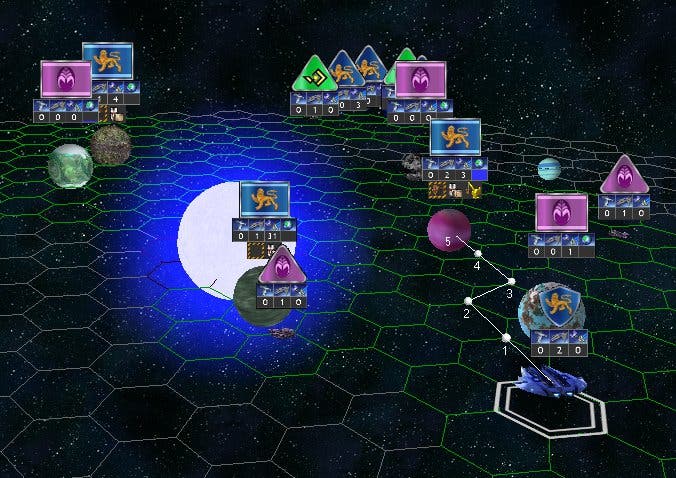Space Empires V
Like Triton, it's big, icy and short of atmosphere.
If you're looking for the sort of review that compares Space Empires V to Space Empires IV then the following is going to disappoint (This is my first foray into the series). If, on the other hand, you're looking for the sort of review that compares an ambitious space colonisation strategy game to a dead badger and mentions gnat testicles and solid gold hats then you're in luck.
Starlight Hexpress
'Ambitious', as every seasoned review reader knows, is almost always a euphemism for 'over-ambitious'. SE5 tries to do a hell of a lot on a titchy development budget, and unsurprisingly winds-up weak in several departments (the most obvious weakness should be evident from the screenshots). The basic premise is turn-based intergalactic imperialism. You're a race - one of a possible 14 - that's out to colonise a vast, randomly generated galaxy of interconnected star systems. The more planets you can occupy, the more resources you'll have at your disposal and the more room you'll have to build the facilities that gather and store those resources, and construct and service your conquest fleet.

It sounds straightforward enough and, initially at least, it is. For a game that's up there with the likes of Paradox's Europa Universalis and Hearts of Iron series in terms of breadth and depth, SE5 is remarkably easy to get to grips with. Digest the text contained in fifty short tutorial messages (a painless 20 minute task) and you're ready to embark on your first domination bid. It's only when you're a few hours into that first marathon that you realise that you know nothing about crucial game aspects like tactical combat, trade, satellites, mines, and drones, and have to go rummaging around in the manual and in-game encyclopaedia.
Lots of space, little opera
The logical way to have introduced topics like these would have been through a gentle introductory mission sequence. SE5 is without such a sequence. In fact, it's without missions of any kind. All Malfador's efforts have gone into a giant freeform campaign mode. While this offers endless replayability through its numerous configuration options, it provides none of the short-term incentives or careful pacing you'll find in scenario-based campaigns. Without a story or optional side missions, every game boils down to roughly the same thing - a relentless rush to expand and consolidate, expand and consolidate, expand and consolidate...

Thankfully enlarging your deep-space dominion isn't just a process of churning out starships and sending them further and further afield. Unlike most strategy fare, SE5 puts a big emphasis on bespoke units. Every planet-smiting super-dreadnought, every humble minesweeper, expendable fighter and bog-standard sputnik is based on a grid-based design drawn-up personally by the player. With hundreds of different components, and dozens of different chassis available by the later stages of a game, your systems can end-up swarming with a startling range of marques and models. Sculpting, testing, tweaking, and naming this exotic shoal is probably the most interesting aspect of the game.
At times you'll be developing new weapons, armour, engine or sensor techs every turn. To take full advantage of these inventions it's necessary to amend ship designs after each discovery. Though upgrading involves just a few button presses per blueprint, the process can get pretty tiresome after a while. There's a similar laboriousness to some other management tasks like rearranging production queues, but overall the interface is more aid than obstruction. Running a large complex empire and operating hundreds maybe thousands of different ships at the same time is made much easier by the presence of silicon ministers - AI entities that can take over the running of vessels or colonies - and a sophisticated fleet system. By concentrating your tubs into flotillas and assigning them roles and behaviours within those formations, you're far less likely to get bushwhacked by every wandering Tom, Dick, and Xyyh'ari.
Dot polka

When two opposing craft or fleets end-up in the same hex the action shifts to either a tactical or a strategic combat resolution screen (your choice). Go with the strategic option and you get to watch coloured dots the size of gnat testicles dancing around on a scanner screen for a few minutes. Marginally more engaging is the tactical option. A kind of down-at-heel Starfleet Command, this mode allows you to conduct skirmishes in real-time on a 2D plane. The scraps are passably entertaining (when the enemy doesn't head for the hills) but visually and aurally drab. There's no sense of scale or drama, no sense that crews are fighting for their lives.
The lack of atmosphere and drama isn't just a problem in the battle layer. The whole game though deep and riddled with potential play paths, often feels as stiff and lifeless as a roadside badger. One turn you destroy a green fleet, invade a brown planet, and get a narky message from the pinks. The next you collapse a blackhole, conduct some espionage, and launch seven new Quark Royal class carriers. You're writing history with a giant fiery pen but somehow there's no sense of moment, no feeling that entire populations are in peril. Shouldn't games about galactic conquest make you feel especially powerful, especially cruel? What does it matter how many planets you've got under your thumb if you can't tour those planets, throttle underlings on a whim or stand on a balcony in a solid gold tricorn hat while millions of people chant your name?
If you're committed enough to provide your own atmosphere and fill in the emotionless blanks with your own imagined stories and power fantasises then Space Empires V is worth a look. Those with less animated imaginations, less patience, and lower tolerances of fusty graphics and long turn resolution times should probably stick with Civ and Total War.
